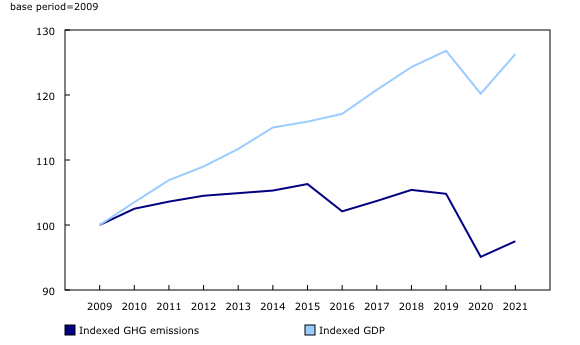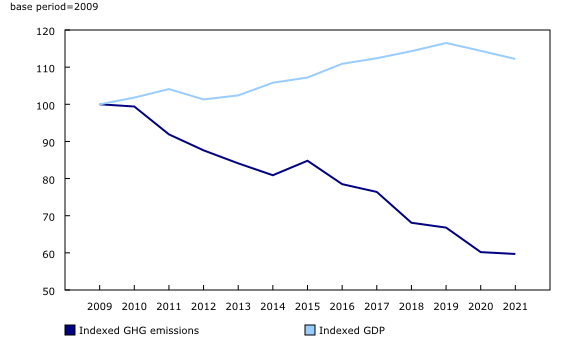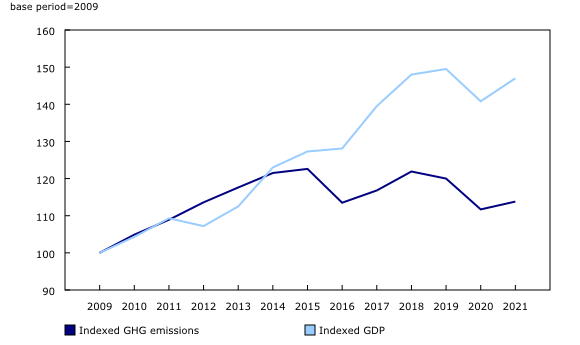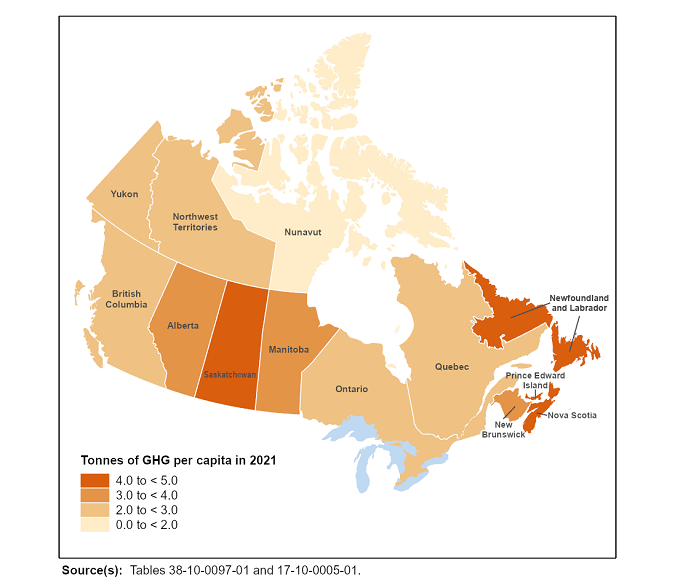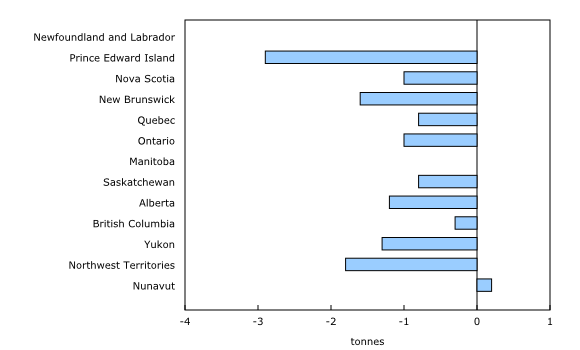Canadian System of Environmental–Economic Accounts: Energy use and greenhouse gas emissions, 2021
Released: 2023-12-20
The energy use and greenhouse gas (GHG) emissions data presented in this release reflect the production and consumption activities of industries, households and governments that contribute to Canada's estimates of gross domestic product (GDP). Canada's economy has been growing at a faster pace than its industrial GHG emissions from 2009 to 2021. During this period, the economy grew 2.0% per year on average, while industrial GHG emissions dropped by 0.2% per year on average.
These GHG emissions estimates are based on the United Nations System of Environmental–Economic Accounting guidelines and differ from the GHG emissions estimates released by Environment and Climate Change Canada, which is responsible for producing the official National Inventory Report: Greenhouse Gas Sources and Sinks in Canada. For more information, please see the Note to readers.
Canada's gross domestic product and industrial greenhouse gas emissions
From 2009 to 2019, before the start of the COVID-19 pandemic, the Canadian economy as measured by real GDP grew 26.8%. Meanwhile, total industrial energy use (+9.9%) and corresponding GHG emissions (+4.8%) both increased. During this period, GHG emissions rose at about one-fifth of the pace of economic growth and about half the pace of industrial energy use.
The significant decrease in energy used by industries (-8.4%) and in industrial GHG emissions (-9.3%) in 2020 can largely be attributed to the COVID-19 pandemic. Once pandemic-related restrictions began to lift in 2021, there was a slight rebound in both the energy used by industries (+3.1%) and industrial GHG emissions (+2.6%). Chart 1 displays the slower growth of GHG emissions when compared with total GDP over the time series.
Over the period from 2009 to 2021, the electric power generation, transmission and distribution industry saw significant declines in GHG emissions as it moved away from coal and toward less GHG intensive energy sources for generating electricity. From 2009 to 2021, GHG emissions from this industry fell by 40.3%, while GDP for the industry rose 12.2% nationally (see Chart 2).
The oil and gas extraction industry remains Canada's top industrial energy user and greenhouse gas emitter
The oil and gas extraction industry continued as Canada's top industrial user of energy in 2021, representing 18.6% of Canada's total energy used. Oil and gas extraction was the highest GHG-emitting industry from 2009 to 2021 and was responsible for 23.2% of Canada's total GHG emissions in 2021. As shown in Chart 3, prior to 2014, GHG emissions from the oil and gas extraction industry grew at a similar pace to GDP; however, from 2014 onwards, this trend changed, with GDP continuing to increase and GHG emissions fluctuating but remaining steady overall.
Households account for more than one-fifth of the total energy used in Canada
Households consumed more than one-fifth (22.0%) of Canada's total energy used in 2021, down slightly from 2020 (22.6%), continuing the downward trend observed since the beginning of the COVID-19 pandemic. Meanwhile, households were responsible for less than one-fifth (16.1%) of Canada's total GHG emissions in 2021.
In 2021, Canada's per capita household GHG emissions decreased by 0.5% to 3.0 tonnes per person, following a significant decrease of 17.3% in 2020, again related to the COVID-19 pandemic.
Top greenhouse gas emitting industries by province and territory
Households were the primary GHG emitters in 2021 across many provinces and territories. Household use of motor fuels and lubricants was the main source of emissions for Newfoundland and Labrador (18.7%), Prince Edward Island (26.4%), Quebec (17.7%) and Ontario (15.2%). This category was the second highest emitter for Yukon (18.3%), behind support activities for mining and oil and gas extraction (21.7%).
Electric power generation, transmission and distribution was the most significant source of GHG emissions in Nova Scotia (42.7%), New Brunswick (24.5%) and Saskatchewan (25.2%) in 2021. Meanwhile, the crop and animal production industry accounted for the largest share of total GHG emissions in Manitoba (36.7%). Pulp, paper and paperboard mills were the largest source of GHG emissions in British Columbia (21.1%).
The oil and gas extraction industry was the largest GHG-emitting industry in Alberta in 2021, accounting for just over half (51.2%) of the province's total emissions. The mining and quarrying sector was the largest GHG emitter in Nunavut and the Northwest Territories; metal-ore mining accounted for just over half of the GHG emissions in Nunavut (51.9%), while non-metallic mineral mining and quarrying accounted for 28.6% of the GHG emissions in the Northwest Territories in 2021.
Did you know we have a mobile app?
Get timely access to data right at your fingertips by downloading the StatsCAN app, available for free on the App Store and on Google Play.
Note to readers
The basis for these greenhouse gas (GHG) estimates presented here is Statistics Canada's physical flow accounts (PFA), which record the annual flows of selected natural resources, products and residuals between the Canadian economy and the environment. Data are presented to reflect the activities of industries, households and governments, and follow the classification system of industries and commodities used in Statistics Canada's supply and use tables. Following the United Nations System of Environmental-Economic Accounting (SEEA), the use of this classification system enables the environmental accounts to be integrated with Canada's economic statistics, such as the gross domestic product.
Environment and Climate Change Canada is responsible for producing the official National Inventory Report: Greenhouse Gas Sources and Sinks in Canada. This inventory, which fulfills Canada's reporting obligations under the United Nations Framework Convention on Climate Change (UNFCCC), is consistent with guidelines published by the Intergovernmental Panel on Climate Change (IPCC) and is the official benchmark for GHG emissions in Canada. National inventories under the UNFCCC and the GHG accounts under the United Nations SEEA are based on different methodological frameworks that result in different GHG estimates; the sector definitions used to create the two products differ and thus the products should not be directly compared. For more information on the methodological differences, see the Canadian System of Environmental-Economic Accounts - Physical Flow Accounts metadata page and the greenhouse gas webpage of the Canadian Centre for Energy Information.
Preliminary data for 2021 from the PFA are now available for national energy use (38-10-0096-01) and national, provincial and territorial GHG emissions (38-10-0097-01). Estimates for 2009 to 2020 for both tables also have been updated due to revised source data.
The products "Physical flow account for energy use: Interactive tool" and "Physical flow account for greenhouse gas emissions: Interactive tool," both part of the Statistics Canada – Data Visualization Products series (71-607-X), are also available. For the latest in energy information in Canada, visit the Canadian Centre for Energy Information website.
Contact information
For more information, or to enquire about the concepts, methods or data quality of this release, contact us (toll-free 1-800-263-1136; 514-283-8300; infostats@statcan.gc.ca) or Media Relations (statcan.mediahotline-ligneinfomedias.statcan@statcan.gc.ca).
- Date modified:


